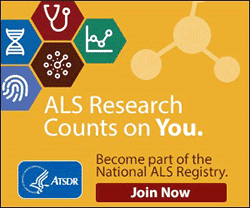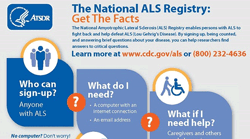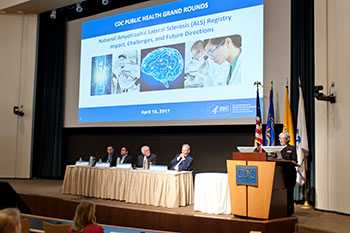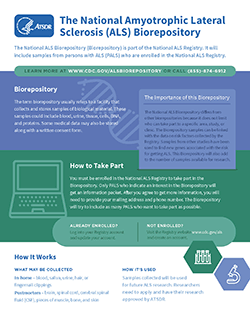National ALS Registry Turns 7

The National ALS Registry has been moving the fight forward against ALS for 7 years now. Learn more about how the Registry works with persons living with ALS, scientists, and others to learn more about this mysterious disease.
It’s been 78 years since Lou Gehrig made his famous “Luckiest Man on Earth” speech when he retired from baseball in 1939 after his diagnosis of ALS. Much about Amyotrophic Lateral Sclerosis (ALS) still remains a mystery. The National ALS Registry is working with persons who are living with ALS, their caregivers and family members, researchers, neurologists, ALS support organizations, and others to help further ALS research.
“The Registry continues to mature and further expand ALS activities by funding research, launching the National ALS Biorepository, and informing persons with ALS about clinical trials and studies. The team is humbled and honored to work with patients, caregivers, and researchers to advance a better understanding of ALS,” says Dr. Paul Mehta, Principal Investigator of the National ALS Registry.

The National ALS Registry is working with persons living with ALS, researchers, and others in the fight against ALS.
Seven Years and Counting
During the 7 years of the National ALS Registry’s existence, ATSDR has made great strides into learning more about ALS. However, we still have a long way to go to fully understand this disease. Regardless, we are extremely grateful to all individuals living with ALS around the U.S. who have dedicated their valuable time and effort to help advance the science of ALS. Without their participation, the Registry would not be where it is today.
The National ALS Registry has many efforts to increase the understanding of ALS, including:
- providing the first and only population-based estimate of ALS prevalence and incidence for the U.S.,
- fulfilling its Congressional mandate to describe the incidence, prevalence, demographics, and risk-factors for persons living with ALS,
- being used as a recruitment tool for clinical trials and epidemiologic research,
- providing funds for external research, and
- integrating a full-scale biorepository into the Registry.
Visit the National ALS Registry website for more information.
What is ALS?
ALS, also known as Lou Gehrig’s disease, is a rapidly progressive, fatal neurological disease that affects nerve cells in the brain and spinal cord, causing nerves in the muscle to die, thereby affecting voluntary muscle movement. On average, persons with the disease die within 2-5 years after being diagnosed. Approximately 5,000 people are diagnosed with ALS every year. We still know very little about ALS, including its cause(s), why ALS strikes some people and not others, as well as how to stop it, but the Registry continues to work to better understand the disease.

Learn more about how the Registry works through the Get the Facts Infographic [192 KB].
What is the National ALS Registry?
To learn more about the disease, the federal Agency for Toxic Substances and Disease Registry (ATSDR) launched the National ALS Registry in October 2010. The Registry gathers data about ALS from people who have the disease in the U.S. through an online web portal, as well as from existing national health databases (Medicare, and the Veterans Administration).
The main goals of the Registry are to:
- describe the incidence and prevalence of ALS,
- describe the demographics of those with ALS, and
- examine risk factors for the disease.
How is the Registry Fulfilling its Goals?
Since the Registry’s launch, ATSDR has been able to provide information about the incidence, prevalence, and demographic characteristics of persons living with ALS in the U.S. The Registry’s second report was published in August 2016, which includes findings from 2012-2013. This report found that nearly 16,000 persons were living with ALS in the U.S. in 2013. ALS continues to be more common in whites, males, and persons between the ages of 60-69.
ATSDR is also conducting several different activities to examine the potential risk factors for ALS. Through the Registry’s 17 online risk factor modules, ATSDR is collecting detailed information from persons living with ALS on such topics as occupation, military history, residential history, and trauma history to better learn about the potential risk factors for developing the disease. To date, nearly 70,000 survey modules have been completed by persons living with ALS. The Registry’s web portal now contains risk factor data on the largest number of individuals with ALS in the U.S. In July 2014, ATSDR published initial results from the Registry’s risk factor survey data in the Registry’s first report, [575 KB] and in April, 2016, ATSDR published preliminary results of the risk factor survey data.
Today, ATSDR continues to analyze the data, and the latest findings will be released in an upcoming Morbidity and Mortality Weekly Report (MMWR).

Panelists at the CDC’s Public Health Grand Rounds, April 2017: National Amyotrophic Lateral Sclerosis (ALS) Registry – Impact, Challenges, and Future
Research
Research is critical to help scientists and persons living with ALS better understand the disease. The overarching goal of the research is to examine potential risk factors for developing ALS. To help identify these potential risk factors, the Registry’s Research Notification Mechanism connects individuals with ALS with scientists who are recruiting participants for their ALS studies and clinical trials. Since this became available, over 90% of Registry-enrolled persons with ALS have chosen to receive email notifications about research opportunities they are eligible for. To date, ATSDR has helped 30 institutions domestically and abroad recruit for research projects. Over 100,000 emails have been sent to Registry-enrolled individuals living with ALS since 2013. Overall, feedback from researchers has been positive.
Funding
ATSDR is also providing funding for academic institutions to conduct research to learn more about risk factors and what may cause ALS. In 2017, the National ALS Registry funded the University of Pittsburgh to identify and characterize potential environmental risk factors for ALS using the National ALS Registry cases and a control population. To date, ATSDR has funded 13 research studies domestically and one international study. Information gleaned from the research will help ATSDR prioritize topics for future surveys.

Learn more with the Biorepository Infographic [105 KB].
National ALS Biorepository
In January 2017, the Registry launched the National ALS Biorepository, which will continue to
- enroll a representative, population-based sample of participants from the Registry;
- increase the number of biological specimens available for research on ALS,
- allow for the correlation of biomarkers with extensive epidemiologic data collected by the National ALS Registry, and
- provide a free service to persons with ALS.
Through the National ALS Biorepository Pilot Study that operated from September 2011 through September 2015, ATSDR collected in-home and post-mortem biospecimens from Registry-enrolled individuals living with ALS. Samples collected included blood, urine, hair, and fingernail clippings from 330 participants, and brains, spinal cords, cerebral spinal fluid (CSF), and pieces of muscle, skin, and bone from 21 participants.
The newly launched National ALS Biorepository has collected samples of blood and urine or saliva from 241 additional individuals living with ALS enrolled in the Registry. In addition, brain, spinal cords, CSF, and pieces of muscle, skin, and bone samples were collected from 4 individuals living with ALS. Pairing the biospecimens of the persons living with ALS with their existing epidemiological and risk-factor data will make this biorepository a rich source for scientists who are conducting research into the cause(s) of ALS.
ALS Research Counts on You
The picture of who has ALS is incomplete, but as more people living with ALS participate in this Registry, the more accurate the picture will become. We encourage everyone to learn more about the Registry and how it is moving the fight forward against ALS. Learn more about the National ALS Registry today!
- Page last reviewed: October 10, 2017
- Page last updated: October 10, 2017
- Content source:
- Agency for Toxic Substances and Disease Registry
- Page maintained by: Office of the Associate Director for Communication, Digital Media Branch, Division of Public Affairs




 ShareCompartir
ShareCompartir